Romania are looking to be one of the tournament’s breakout teams at this summer’s EURO U21 Championship, with a squad full of young players from their home country’s SuperLiga, as well as some names who are playing in Europe’s top leagues and will want to show the world their talent.
Despite not boasting one of the favourites, Emil Săndoi’s team will look to stamp their mark on the group that they share with Spain, Croatia and Ukraine, three teams with offensive power and full of talents that play all over Europe.
Within a more vertical and direct approach and an aggressive but low block, Romania show interesting resources and automatisms that could help them wreak havoc in qualifying for the next phase of the competition. In this tactical analysis we’re going to review the tactics of Romania’s U-21 side and an in-depth analysis of their possible list of players in the competition.
Predicted starting XI
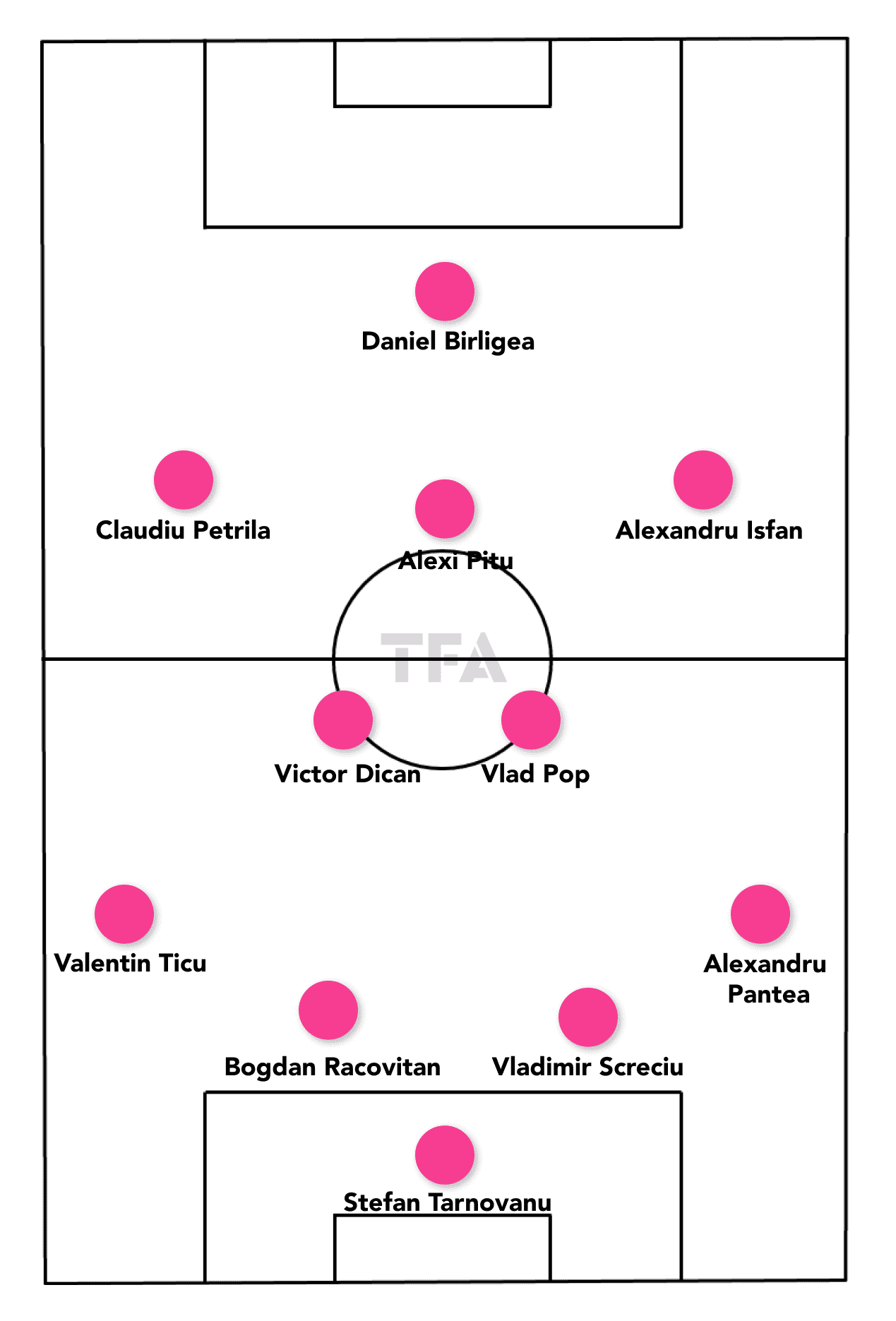
Romania, in their recent matches, decided on a 4-2-3-1 and, it must be made clear that a lot can happen between now and the start of the tournament, such as injuries, absences of some players and changes in formations. This is a prediction of what we expect to see taking into account what has been observed from Emil Săndoi’s selections previously.
Ștefan Târnovanu in goal seems realistic, accompanied by a back-four from the left-back Valentin Țicu, captain Vladimir Screciu, Rakow Czestochowa’s Bogdan Racovițan, and Alexandru Pantea at right-back, the youngest in the line.
In the double-pivot, despite the fact that Săndoi has many options, Vlad Pop and Victor Dican seem to be the candidates to enter that XI of the Romanian team due to their different profiles and leadership on the pitch, accompanied by Girondins Bordeaux’s Alexi Pitu as a ’10’.
Later, completing the starting XI, it is expected to see Alexandru Ișfan and Claudiu Petrila as wingers, with Daniel Bîrligea as centre-forward, being able to constantly rotate with Jovan Marković.

Attacking Phase
Romania show concepts of a more direct football within their offensive approach and in their 4-2-3-1 which predominantly uses the wings to progress, as well as their attacking midfielder to shake up the rival lines in case they want to be more aggressive breaking the block through the central channels of the field.
In the early stages of progression, Emil Săndoi’s team has a couple of principles that are key to practising their offensive game and reaching the rival’s box: 1. Attract with the first line — the four defenders; 2. Play long balls which are varied, sometimes going diagonally and to the foot of the winger, sometimes to the striker to hold up, and sometimes to the space for the forwards to go in behind.
The first passes see the ball move from side to side between full-back-centre-back-full-back. They can turn the game from one side to another or repeat the same looking to move the rival block to later control oriented and execute long passes. The double-pivot is in charge of fixing rival players in the press, attracting them close to their own box so that a wide space is generated between rival centre-backs and central midfielders — there, they can look for the centre-forward or attacking midfielder to hold up play.
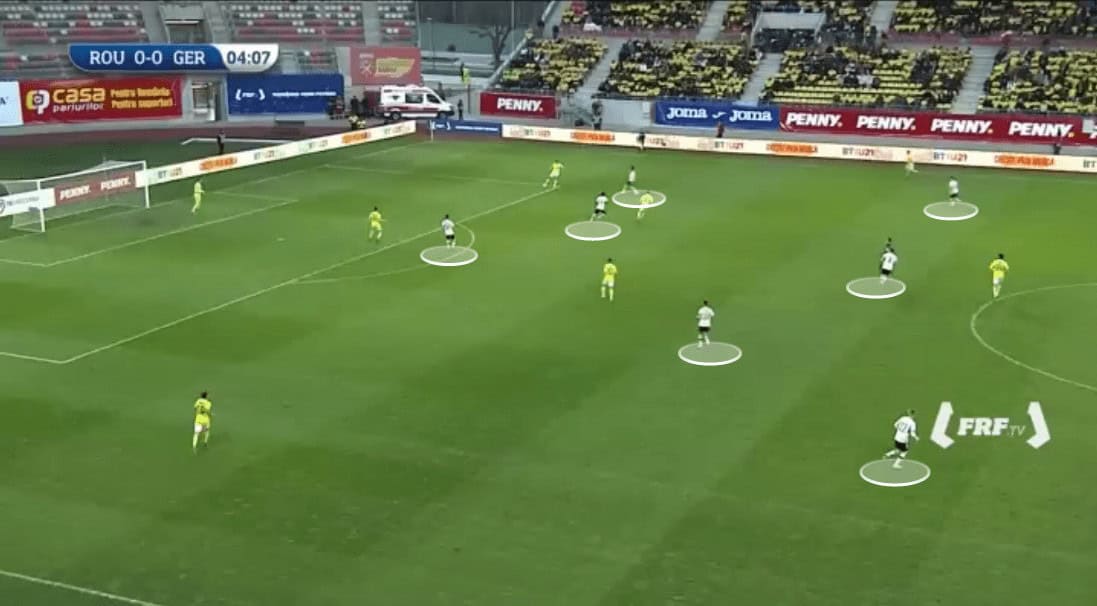
These passes into space vary between the centre-back or some of the midfielders of the double-pivot who have been able to receive and turn their body, thus directing the next pass to a search to dynamise the attack with a long ball towards the wingers.
However, not all executions are long, they prioritise energising attacks with triangulations and link-up play with one-two touches, to later turn the game towards the weak side, connecting with the winger and the latter subsequently accelerating and changing his pace to create threat.
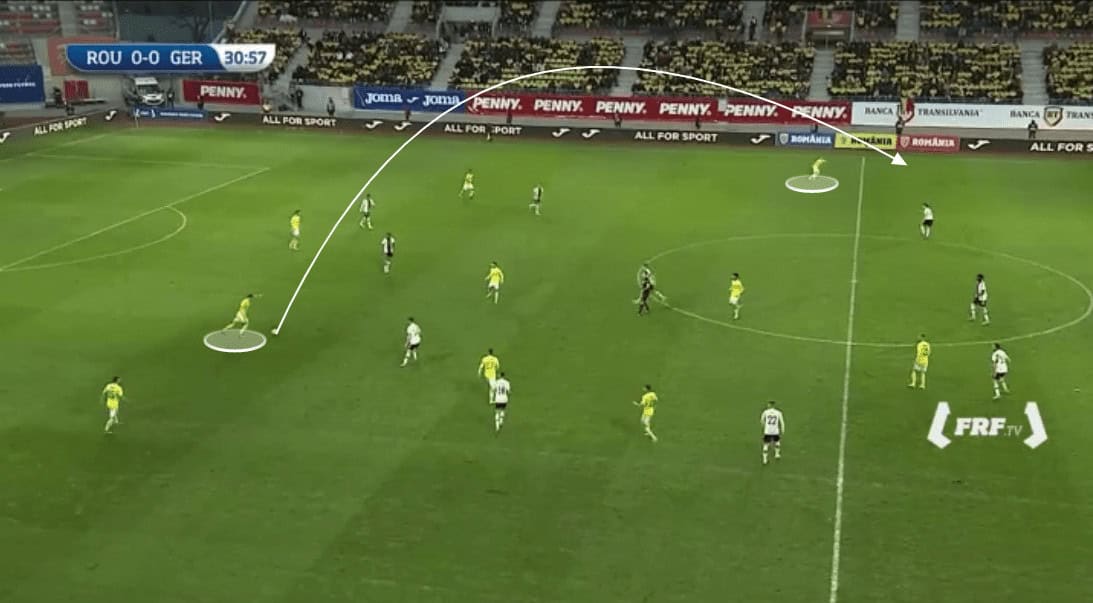
There is a fairly clear automatism when they want to go out on top and connect with the centre-forward, which shows an interesting and strong back-to-goal play. When the type of execution is clear, the collective movement towards the attack is quickly understood and they position themselves solidly.
Wingers recognise the type of pass, so they take their role in this type of situation, which is to run down their flanks, seeking to perform dismarking movements in behind. The attacking midfielder is presented as an option to unload the pass for the centre-forward. The ‘rule’ in this type of pass is that the striker has to always see one or two close teammates to give the ball and two other teammates drawing runs to his sides.
One of the rotations in these types of direct plays is that one of the wingers could approach a player near the centre-forward and the full-back has to be the player running down the channel to activate into space.
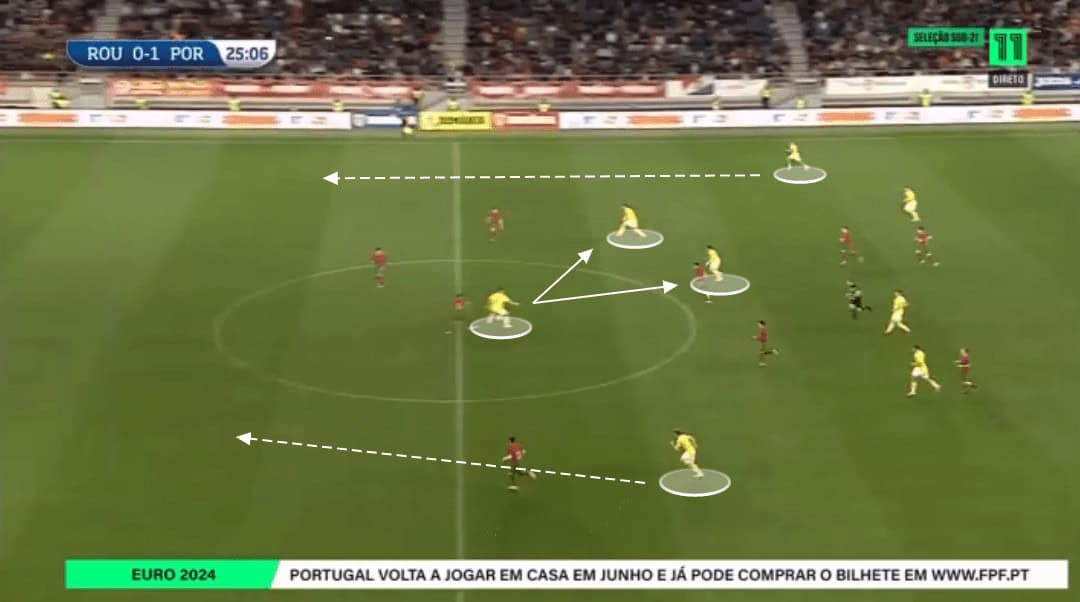
When they want to be more patient and a little braver to play the ball on the ground and try to dynamise processes in the same way, Romania look for wide overloads with up to three players, with one of the central midfielders approaching, the strong side winger on the ball and the full-back who is normally the one that gives the first pass.
The idea within the triangulation that they usually generate is that the last one to receive can turn with space and time to connect with the attacking midfielder and that the latter then leads and commands the attack transition, which becomes very fast in a matter of seconds, getting movement in behind from the closest centre-forward or winger.
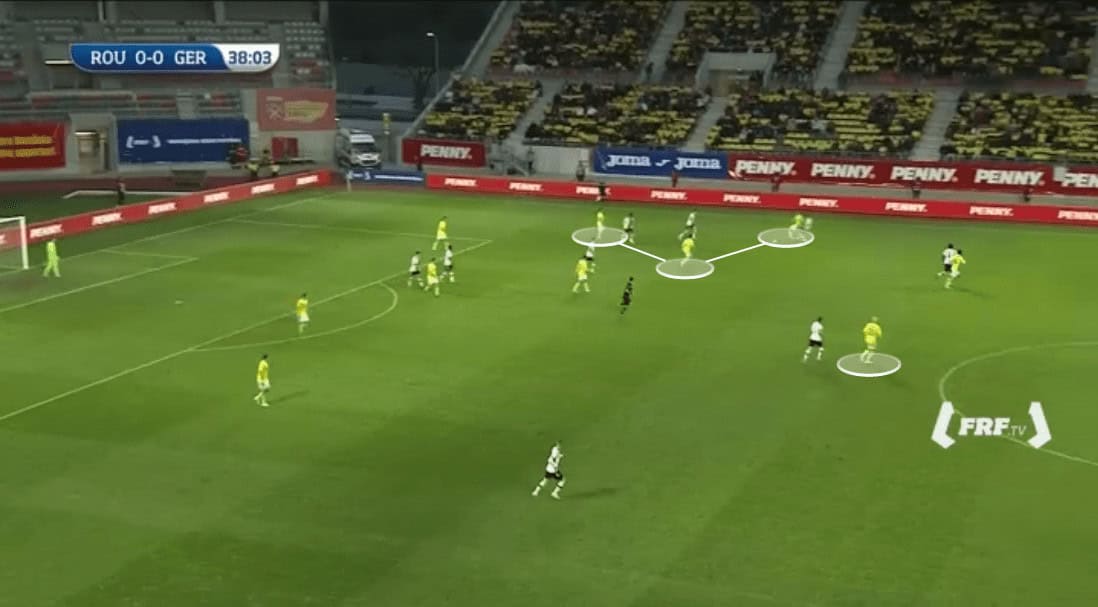
Arriving at the last third, certain automated movements can be observed to generate attacks with an idea behind them and which are not flat beyond what they can do when they have space. When teams look to close them out with lower or mid blocks, they show some interesting moves.
The strong-side-of-the-ball winger usually stays open, although they can exchange the position with the full-back while the winger plays more in the half-space. There, he finds off-the-ball dynamism of certain players — especially the attacking midfielder and centre-forward — between one setting and the other attacking centre-back-full-back intervals which is something extremely regular that is seen in these types of moments.
However, it is not something that is always seen since Romania looks to reach the rival third in a matter of seconds and being direct, finishing the play quickly.
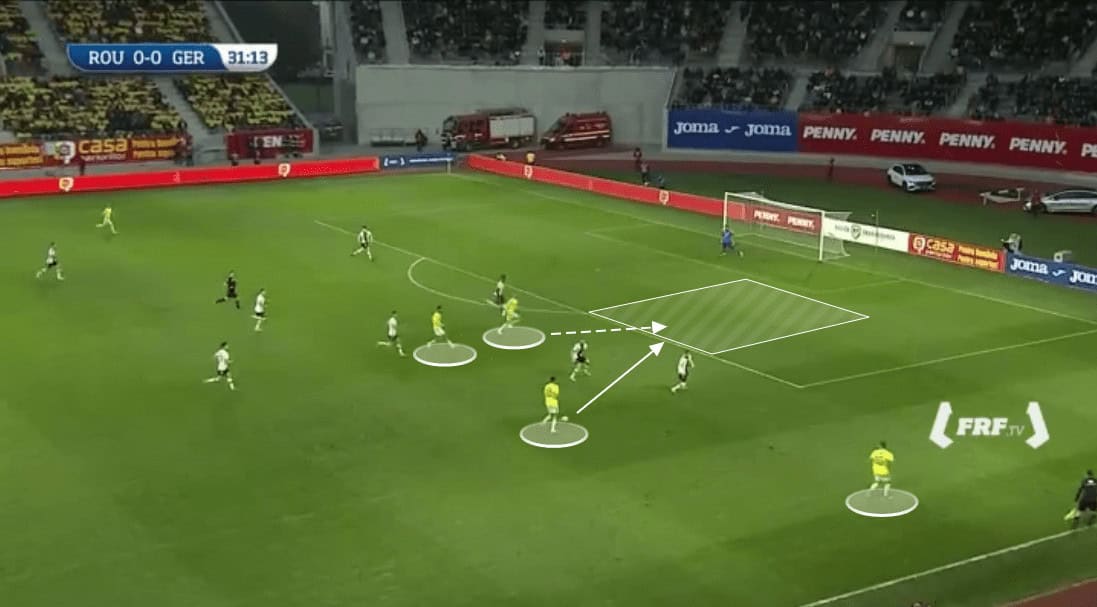
Romania show interesting nuance and resources in this approach, with intelligent collective movements and speed in attacks to be more direct and do damage with their attacking transitions that usually look for in-behind movements and the pace of their wingers, as well as the quality technique of the attacking midfielder, to activate them.
Defensive Phase
Romania have conceded 10 goals in their last five games preparing for the competition — an average of two per game, in which their defensive block proved not to be one of the most rigid. This was despite playing with an aggressive, fairly low block.
It is expected that in the Euro U21 tournament, we will see this low block again, especially against Spain U21, with whom they met in one of their last five games, with them playing in the same defensive way.
They look to defend in a 4-5-1 that has aggressive behaviors within certain zones which themselves limit the rival team from progressing. They rotate between jumps of the full-back or centre-back with rotation between them and the midfielders to enter the different lines where spaces are being left.
Wingers can sometimes be seen dropping down to create a back-five down the side where the ball is moving. However, it is common to see the shape of the five midfielders, with one dropping lower to cover the area in front of the defenders.
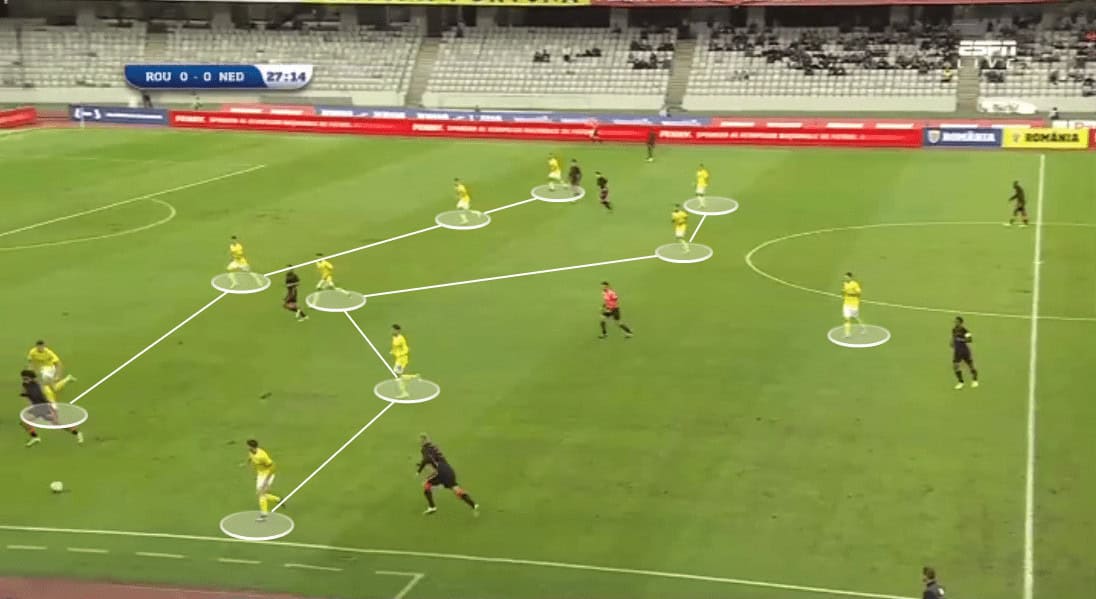
The jumps are quite common and vary between different areas and players in charge of making them. The first comes from the first line of pressure, which is in charge of blocking the initial passes and suffocating the ball-holders who play facing the goal with more patience to break their block.
If the opponent looks to move the ball from side to side, they jump between the striker, then the attacking midfielder in a position closer to centre-forward and, finally, a winger. Whether they steal the ball or not, the idea here of these players is to force the opponent to restart constantly without generating a threat.
In the event that the ball progresses from the outside, the full-backs do not have any type of problem in stepping off their line quite aggressively, with attentive movements by wingers or central midfielders to cover the space that they are leaving behind them, as well as centre-backs.
It is common to see how midfielders in the central channels also carry out this type of more proactive movement, an area in which they do not allow the passage of the rival, blocking passing lanes as well as cutting and anticipating ball carriers or even ball-receivers, who are stifled by two nearby players.
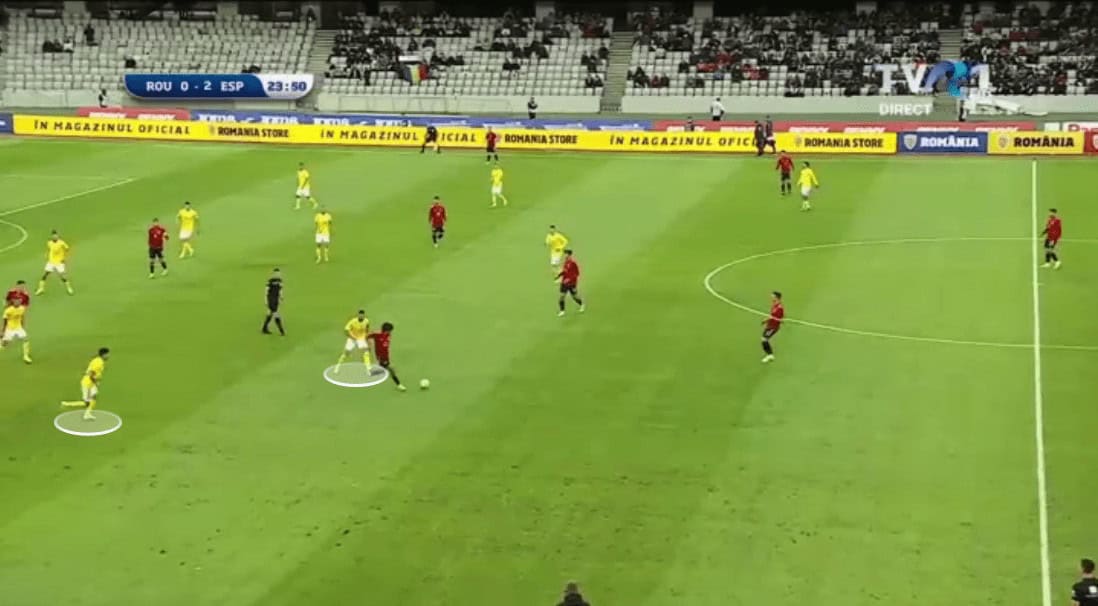
One of those areas that they limit the most is the central channel in front of defenders. Opposing players usually want to receive between the lines to shake them up and then evade the pressure to go face-to-face with the back-four.
The midfielders, in this case practically three since the double-pivot always adds one between some winger, attacking midfielder or even centre-back making a jump, showing their aggressiveness not to let anyone receive — especially in this channel.
Although it can usually be seen that Romania allow the opponent to play patiently, this is also a mental game on their part to stress the opponent and find the right moment to steal. The triggers are clear for the players of the team — to win the ball back and then launch passes in behind.
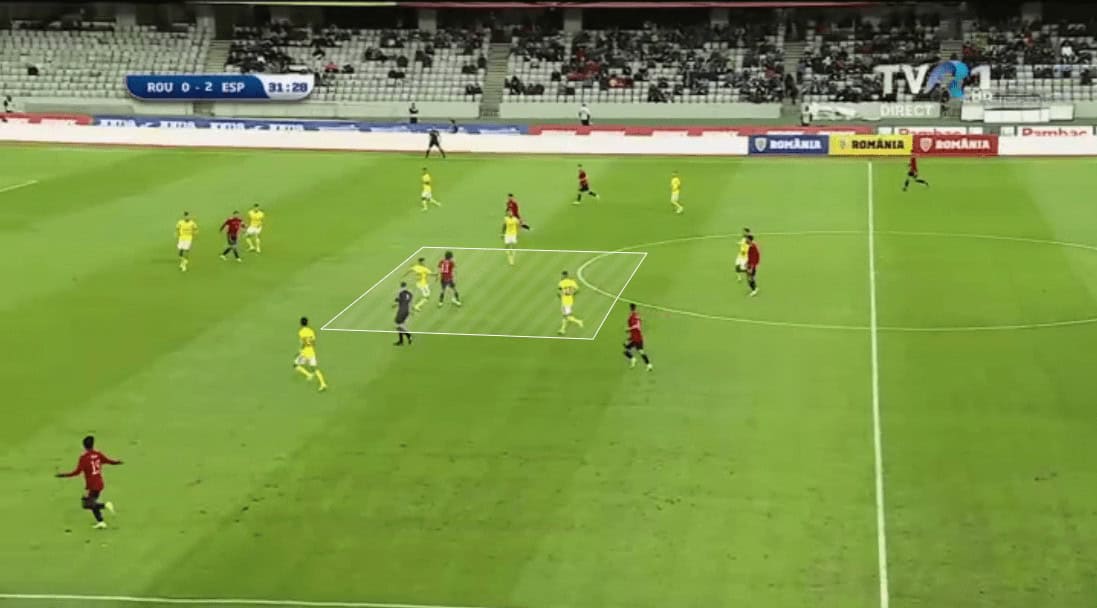
Romana opt for a lower block, which has aggressive behaviors to change pressure and attack triggers in certain areas — and rotate to cover spaces. However, the rival teams have also found a lot of passivity when they tend to attract them close to free up spaces, being easily agitated to weaken their block.
With certain problems in this phase and in others that involve defence, the Romanian squad will have to carry out a high-quality defensive exercise against teams like Spain, Ukraine or Croatia in their Euro U21 group, with this being one of their weak points against offensively powerful national teams.
Transitions
Romania can encounter problems in defensive transitions, where they seek to rearm quickly, but teams have discovered weaknesses in these situations — especially because of how passive Romania can become in this phase, allowing more time for the opponent’s actions. This entails having to defend threatening plays.
Being a team that suffers a lot of damage in such situations, they have decided in recent matches to turn into a team that uses lower but aggressive blocks as we showed in the defensive phase, in order to nullify fast counterattacks and with a lot of space against them.
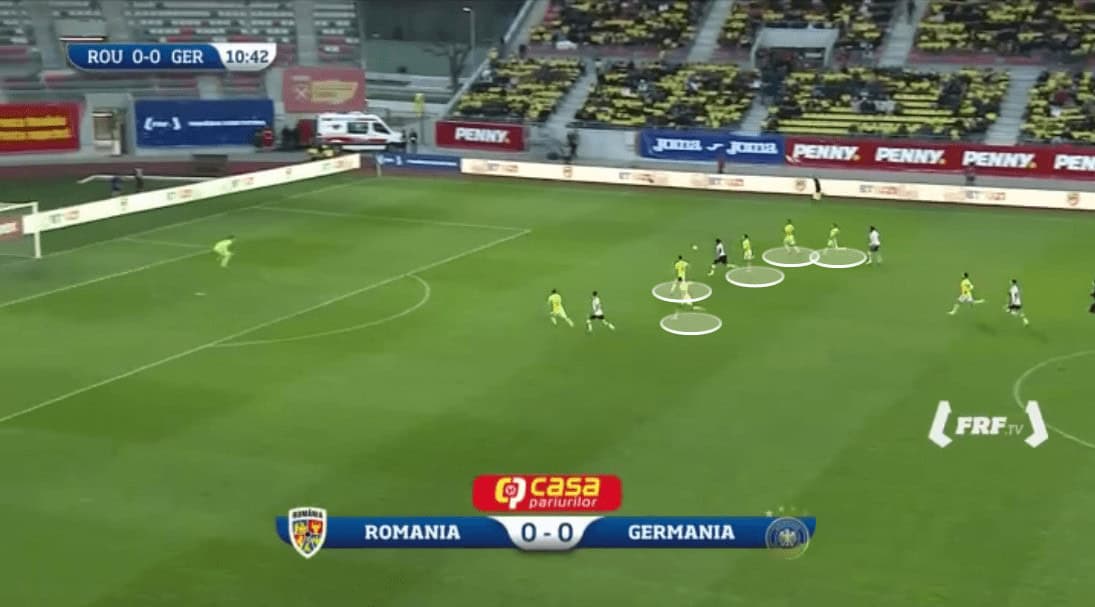
In this image, you can see certain repetitive patterns within the structure of the team when they must defend transitions. Passivity reigns above any other behaviour. The ball carrier — in this case of Germany U21s — had two players close to him before releasing the ball who did not take any action to try and take away the angle of vision.
On the other hand, the dismarking movement from the German player even becomes slow, which is recognisable from several metres before. The rival player does not change direction but still receives and is capable of shooting after moving a few metres towards the penalty area. This only showcases the passivity they have to defend in these situations.
However, when they generate attacking transitions, they look to make the most of them with their fast play on the wings, adding three to four players — usually the wingers, the ’10’ and a full-back that arrives much more open — as an option. They put great focus on these attacks since they are the ones they use the most within their direct style of play.
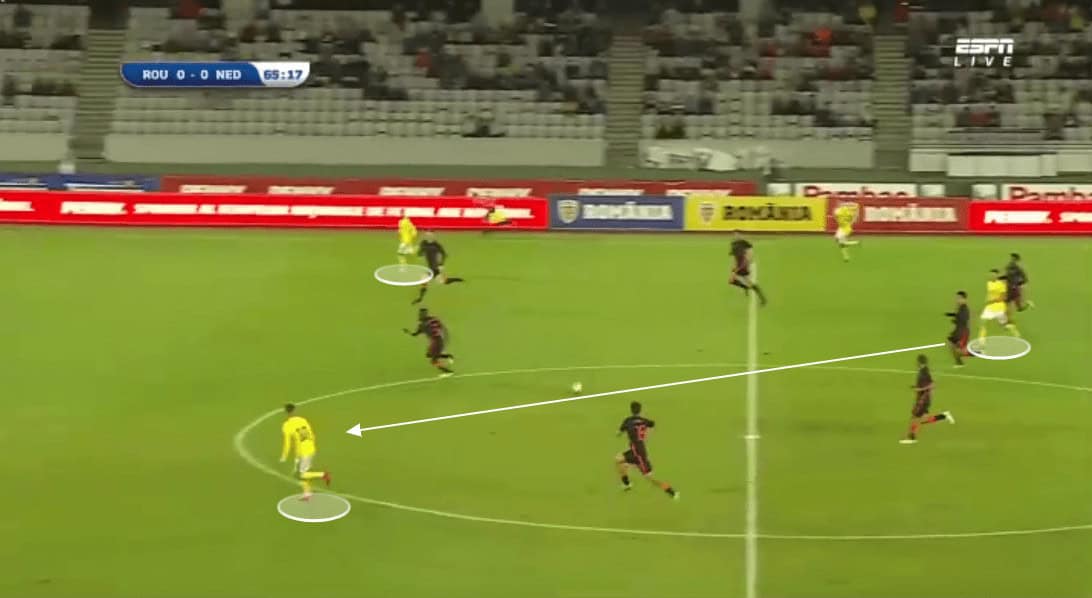
As we can see in this example, Romania look to use their pressing traps to steal the ball in the middle, command the transition from the central channel and wait for the dismarking runs of players in more open channels. We can see them making movements with changes of direction from the outside channel to the inside, with a centre-forward also pulling more to the side.
The idea within their transitions is to take advantage of the verticality and speed on the wings. The attacking midfielder must make the passes and drive forward with the ball, as they look for him to receive regularly in this and not be the one who runs in behind.
Forwards
One area where Romania show great quality, and probably where they have the most and best options, is in attack. With striking names like the aforementioned Alexi Pitu, or Maccabi Tel-Aviv’s winger, Rareș Illie, the technical level of dribbling and explosiveness is quite interesting.
Then, names with more experience like Alexandru Ișfan, one of the best players on the squad, accompanied by Daniel Bîrligea in a more centralised role, and Claudiu Petrila on the wings, are some of the best players Romania has in this area.
David Miculescu, Jovan Marković, Alexandru Tirlea and Constantin Grameni are some of the Romanian team’s backup options in attack.
Midfielders
Within the double-pivot they use, Vlad Pop and Victor Dican, both 22 years old, aim to be the starting pairing at the start of the tournament. The former is a player with more attacking skills and on the right foot, while Dican, who captains his team in the SuperLiga, offers coverage and space awareness.
Later, the ’10’ of the team is a position that can rotate commonly, but Alexi Pitu, from Girondins de Bordeaux, is one of the players with the most image in Europe and has excellent abilities with the ball to play the direct game of his national team. He can also play as a winger.
Dragoș Albu, Mihai Lixandru, Ștefan Baiaram and Marius Corbu are the backup options for the Romania team in midfield.
Defenders
Romania have an interesting backline, which is expected to see captain Vladimir Screciu as one of the starters, as well as Bogdan Racovițan, the only one of the coach’s selections from this line who is part of a club from outside his native country.
Marco Ehmann and Victor Dican as more versatile options, who can play in midfield, will be the names to watch out for should there be any casualties there.
On the wings, 19-year-old Alexandru Pantea, who has more than 800 minutes in the Romanian Super League, will be the possible starter at right-back, with the more experienced 23-year-old Valentin Țicu at left-back. Andres Dimitrescu and Alexandru Țîrlea aim to be the players waiting for a chance off the bench.
Key Player
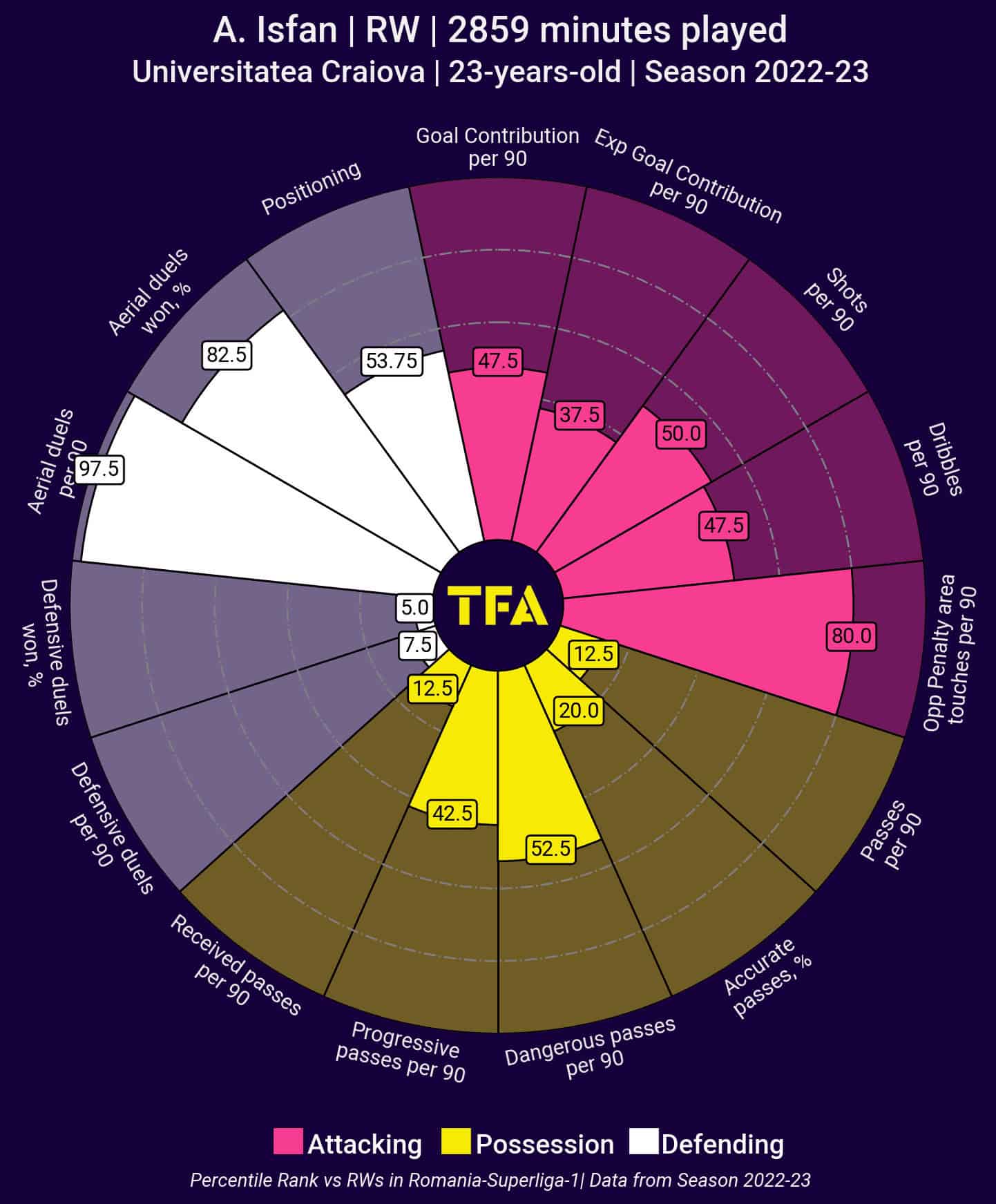
Getting to the final part of this scout report, we choose the best player in Romania, we have thought about the one who can offer the most according to his idea of the game — therefore, Alexandru Ișfan was chosen.
Being a quick enough winger to go in behind with good technique in his dribbling and certain decisions reaching the box to finish off chances or assist them within the direct game that looks to open up a lot towards the wings, Ișfan could be key for his team.
He also shows great ability tactically and mentally because of his movements off the ball and the intense way he wants to go always forward to try and win the game.
Tournament prediction
Romania have not shown their best game within the performances that have prepared them for the upcoming Euro U21. Despite this, they have some interesting names that can stand out for the national team in the tournament.
However, they will have to show the best version of themselves in all phases and collect their best players in great shape to outperform the people’s predictions.

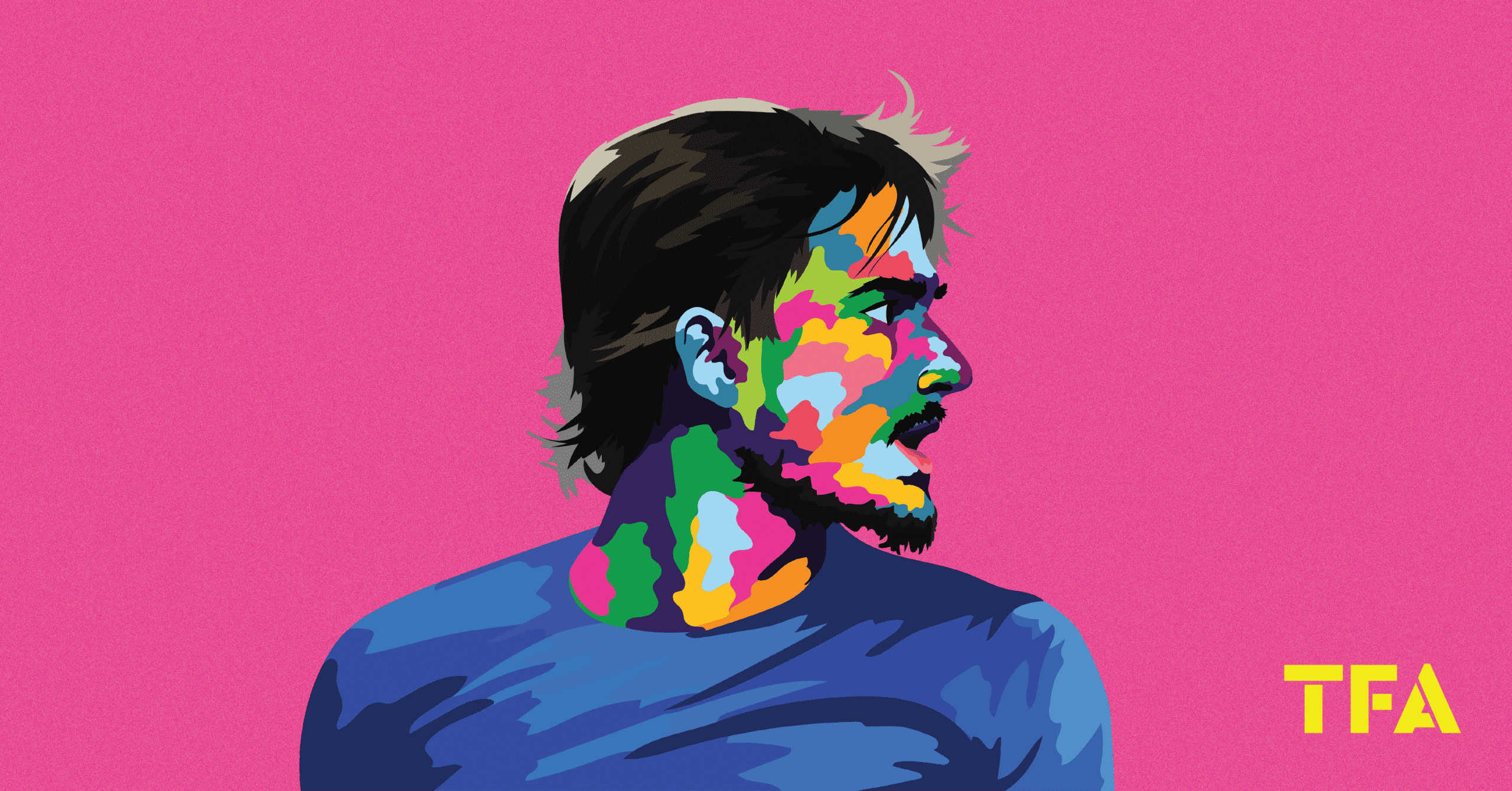




Comments